Tower of London: Difference between revisions
m clean up, typos fixed: hstory → history |
No edit summary |
||
| Line 12: | Line 12: | ||
|ownership=The Crown | |ownership=The Crown | ||
}} | }} | ||
'''The Tower of London''', formally known as ''' | '''The Tower of London''', formally known as '''His Majesty's Royal Palace and Fortress''' is a castle standing on the north bank of the [[River Thames]] in metropolitan [[Middlesex]]. It is separated from the eastern edge of the square mile of the [[City of London]] by the open space known as [[Tower Hill]]; in former days the Tower and its immediate vicinity were excluded from the authority of both the city and the county magistrates as "the Tower Liberties". | ||
The Tower of London was founded towards the end of 1066 to secure for London for William of Normandy as part of the Norman Conquest of England in that year. The White Tower, which gives the entire castle its name, was built by William the Conqueror in 1078, and was a resented symbol of the domination of the new ruling elite. The castle was used as a prison from 1100 (Ranulf Flambard) until 1952 (the Kray twins),<ref>[http://www.hrp.org.uk/discoverthepalaces/FAQs#11 tower of London website – Last Prisoners]</ref> although that was not its primary purpose. A grand palace early in its history, it served as a royal residence. | The Tower of London was founded towards the end of 1066 to secure for London for William of Normandy as part of the Norman Conquest of England in that year. The White Tower, which gives the entire castle its name, was built by William the Conqueror in 1078, and was a resented symbol of the domination of the new ruling elite. The castle was used as a prison from 1100 (Ranulf Flambard) until 1952 (the Kray twins),<ref>[http://www.hrp.org.uk/discoverthepalaces/FAQs#11 tower of London website – Last Prisoners]</ref> although that was not its primary purpose. A grand palace early in its history, it served as a royal residence. | ||
| Line 23: | Line 23: | ||
In the absence of the monarch, the Constable of the Tower is in charge of the castle. This was a powerful and trusted position in the mediæval period. In the late 15th century the castle was the prison of the Princes in the Tower. Under the Tudors, the Tower became used less as a royal residence, the gentle palaces of [[Richmond, Surrey|Richmond]], Nonsuch and [[Hampton Court]] being much preferred, and despite attempts to refortify and repair the castle its defences lagged behind developments to deal with artillery. | In the absence of the monarch, the Constable of the Tower is in charge of the castle. This was a powerful and trusted position in the mediæval period. In the late 15th century the castle was the prison of the Princes in the Tower. Under the Tudors, the Tower became used less as a royal residence, the gentle palaces of [[Richmond, Surrey|Richmond]], Nonsuch and [[Hampton Court]] being much preferred, and despite attempts to refortify and repair the castle its defences lagged behind developments to deal with artillery. | ||
The fame or infamy of the Tower in the popular imagination is | The fame or infamy of the Tower in the popular imagination is its role as a state prison. The peak period of this use was the 16th and 17th centuries, when many figures who had fallen into disgrace were kept here, including Princess Elizabeth, sent here by her sister 'Bloody Mary' before Elizabeth herself became queen. This use as a prison has led to the phrase "sent to the Tower". | ||
Despite its enduring reputation as a place of torture and death, popularised by 16th-century propagandists and 19th-century writers, only seven people were executed within the Tower before the World Wars of the 20th century, although many executions did take place on the notorious [[Tower Hill]] to the north of the castle; 112 were carried out there over a 400-year period. In the latter half of the 19th century, institutions such as the Royal Mint moved out of the castle to other locations, leaving many buildings empty. Anthony Salvin and John Taylor took the opportunity to restore the Tower to what was felt to be its mediæval appearance, clearing out many of the vacant post-mediæval structures. | Despite its enduring reputation as a place of torture and death, popularised by 16th-century propagandists and 19th-century writers, only seven people were executed within the Tower before the World Wars of the 20th century, although many executions did take place on the notorious [[Tower Hill]] to the north of the castle; 112 were carried out there over a 400-year period. In the latter half of the 19th century, institutions such as the Royal Mint moved out of the castle to other locations, leaving many buildings empty. Anthony Salvin and John Taylor took the opportunity to restore the Tower to what was felt to be its mediæval appearance, clearing out many of the vacant post-mediæval structures. | ||
| Line 107: | Line 107: | ||
During Edward II's reign (1307–1327) there was relatively little activity at the Tower of London.<ref>{{harvnb|Impey|Parnell|2000|p=41}}</ref> However, it was during this period that the Privy Wardrobe was founded. The institution was based at the Tower and responsible for organising the state's arms.<ref>{{harvnb|Lapper|Parnell|2000|p=28}}</ref> Margaret de Clare, Baroness Badlesmere became the first woman imprisoned in the Tower of London after she refused Queen Isabella admittance to [[Leeds Castle]]<ref>{{harvnb|Wilson|1998|p=40}}</ref> and ordered her archers to fire upon Isabella, killing six of the royal escort.<ref>{{harvnb|Costain|1958|pp=193–195}}</ref><ref>Calendar of Patent Rolls. 1321–1327. p. 29</ref><ref>{{harvnb|Strickland|1840|p=201}}</ref> Generally reserved for high-ranking inmates, the Tower was the most important royal prison in the country.<ref>{{harvnb|Friar|2003|p=235}}</ref> However it was not necessarily very secure, and throughout its history prisoners bribed guards to help them escape. In 1322 in the reign of Edward II, Roger Mortimer, 1st Earl of March, was aided in his escape from the Tower by the Sub-Lieutenant of the Tower who let Mortimer's men inside: they hacked a hole in his cell wall and Mortimer escaped to a waiting boat for France. Having seduced Edward's Queen, Mortimer returned, captured the Tower, released the prisoners held there and imprisoned the King in [[Pontefract|Pomfret]], later having him murdered. For three years Mortimer ruled the realm while Edward III was too young, but in 1330, Edward threw Mortimer back into the Tower.<ref>{{harvnb|Wilson|1998|pp=34, 42–43}}</ref> | During Edward II's reign (1307–1327) there was relatively little activity at the Tower of London.<ref>{{harvnb|Impey|Parnell|2000|p=41}}</ref> However, it was during this period that the Privy Wardrobe was founded. The institution was based at the Tower and responsible for organising the state's arms.<ref>{{harvnb|Lapper|Parnell|2000|p=28}}</ref> Margaret de Clare, Baroness Badlesmere became the first woman imprisoned in the Tower of London after she refused Queen Isabella admittance to [[Leeds Castle]]<ref>{{harvnb|Wilson|1998|p=40}}</ref> and ordered her archers to fire upon Isabella, killing six of the royal escort.<ref>{{harvnb|Costain|1958|pp=193–195}}</ref><ref>Calendar of Patent Rolls. 1321–1327. p. 29</ref><ref>{{harvnb|Strickland|1840|p=201}}</ref> Generally reserved for high-ranking inmates, the Tower was the most important royal prison in the country.<ref>{{harvnb|Friar|2003|p=235}}</ref> However it was not necessarily very secure, and throughout its history prisoners bribed guards to help them escape. In 1322 in the reign of Edward II, Roger Mortimer, 1st Earl of March, was aided in his escape from the Tower by the Sub-Lieutenant of the Tower who let Mortimer's men inside: they hacked a hole in his cell wall and Mortimer escaped to a waiting boat for France. Having seduced Edward's Queen, Mortimer returned, captured the Tower, released the prisoners held there and imprisoned the King in [[Pontefract|Pomfret]], later having him murdered. For three years Mortimer ruled the realm while Edward III was too young, but in 1330, Edward threw Mortimer back into the Tower.<ref>{{harvnb|Wilson|1998|pp=34, 42–43}}</ref> | ||
King Edward III (1312–1377) | King Edward III (1312–1377) restored English power and prosperity and later in his realm he restored the dilapidated Tower of London. | ||
When Richard II was crowned in 1377, he led a procession from the Tower to Westminster Abbey, which began a tradition which lasted until the coronation of King Charles II. During the Peasants' Revolt of 1381 the Tower of London was besieged with the King inside. When Richard rode out to meet with Wat Tyler, the rebel leader, a crowd broke into the castle without meeting resistance and looted the Jewel House. The Archbishop of Canterbury, Simon Sudbury, took refuge in St John's Chapel, hoping the mob would respect the sanctuary but he was taken away and beheaded on Tower Hill.<ref name="Parnell 1993 53">{{harvnb|Parnell|1993|p=53}}</ref> Six years later there was again civil unrest, and Richard spent Christmas in the security of the Tower rather than Windsor as was more usual.<ref>{{harvnb|Impey|Parnell|2000|p=44}}</ref> When Henry Bolingbroke returned from exile in 1399, King Richard was imprisoned in the White Tower, where he was forced to abdicate in favour of Henry, though it did him little good: Richard was murdered in the Tower. | When Richard II was crowned in 1377, he led a procession from the Tower to Westminster Abbey, which began a tradition which lasted until the coronation of King Charles II. During the Peasants' Revolt of 1381 the Tower of London was besieged with the King inside. When Richard rode out to meet with Wat Tyler, the rebel leader, a crowd broke into the castle without meeting resistance and looted the Jewel House. The Archbishop of Canterbury, Simon Sudbury, took refuge in St John's Chapel, hoping the mob would respect the sanctuary but he was taken away and beheaded on Tower Hill.<ref name="Parnell 1993 53">{{harvnb|Parnell|1993|p=53}}</ref> Six years later there was again civil unrest, and Richard spent Christmas in the security of the Tower rather than Windsor as was more usual.<ref>{{harvnb|Impey|Parnell|2000|p=44}}</ref> When Henry Bolingbroke returned from exile in 1399, King Richard was imprisoned in the White Tower, where he was forced to abdicate in favour of Henry, though it did him little good: Richard was murdered in the Tower. | ||
In the 15th century the Tower was a place of refuge and imprisonment; when supporters of the late Richard II attempted a coup, Henry IV found safety in the Tower of London. During this period, the castle also held many distinguished prisoners. The heir to the Scottish throne, later King James I, was kidnapped while journeying to France in 1406 and held in the Tower; he was | In the 15th century the Tower was a place of refuge and imprisonment; when supporters of the late Richard II attempted a coup, Henry IV found safety in the Tower of London. During this period, the castle also held many distinguished prisoners. The heir to the Scottish throne, later King James I, was kidnapped while journeying to France in 1406 and held in the Tower; he was still here when proclaimed king. The vistories in France of [[Henry V (1413–1422) brought many high-status prisoners to be held in the Tower of London until they were ransomed.<ref>{{harvnb|Impey|Parnell|2000|p=45}}</ref> | ||
The mid-15th century was rent by the Wars of the Roses. In 1460 the Tower was besieged and damaged by Yorkist artillery, and surrendered when Henry VI was captured at the Battle of Northampton. After a brief restoration, Henry was imprisoned in the Tower, where he was probably murdered.<ref name="Parnell 1993 53"/> During the wars, the Tower was fortified to withstand gunfire, and provided with loopholes for cannons and handguns: an enclosure was created for this purpose to the south of Tower Hill, although it no longer survives. | The mid-15th century was rent by the Wars of the Roses. In 1460 the Tower was besieged and damaged by Yorkist artillery, and surrendered when Henry VI was captured at the Battle of Northampton. After a brief restoration, Henry was imprisoned in the Tower, where he was probably murdered.<ref name="Parnell 1993 53"/> During the wars, the Tower was fortified to withstand gunfire, and provided with loopholes for cannons and handguns: an enclosure was created for this purpose to the south of Tower Hill, although it no longer survives. | ||
Latest revision as of 11:15, 10 December 2022
| Tower of London | |
|
Middlesex | |
|---|---|
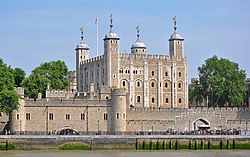 The Tower of London, from the River Thames | |
| Location | |
| Grid reference: | TQ336805 |
| Location: | 51°30’29"N, 0°4’34"W |
| History | |
| Built 1078, 1190s, 1285, 1377–1399 | |
| Information | |
| Condition: | Complete |
| Owned by: | The Crown |
The Tower of London, formally known as His Majesty's Royal Palace and Fortress is a castle standing on the north bank of the River Thames in metropolitan Middlesex. It is separated from the eastern edge of the square mile of the City of London by the open space known as Tower Hill; in former days the Tower and its immediate vicinity were excluded from the authority of both the city and the county magistrates as "the Tower Liberties".
The Tower of London was founded towards the end of 1066 to secure for London for William of Normandy as part of the Norman Conquest of England in that year. The White Tower, which gives the entire castle its name, was built by William the Conqueror in 1078, and was a resented symbol of the domination of the new ruling elite. The castle was used as a prison from 1100 (Ranulf Flambard) until 1952 (the Kray twins),[1] although that was not its primary purpose. A grand palace early in its history, it served as a royal residence.
Overview and significance
As a whole, the Tower is a complex of several buildings set within two concentric rings of defensive walls and a moat. There were several phases of expansion, mainly under such active kings as Richard the Lionheart, Henry III, and Edward I in the 12th and 13th centuries. The general layout established by the late 13th century remains despite later activity on the site.
The Tower of London has played a prominent role in history. It was besieged several times and controlling it has been important to controlling the country. The Tower has served variously as an armoury, a treasury, a menagerie, the home of the Royal Mint, a public records office, and the home of the Crown Jewels of the United Kingdom. From the early 14th century until the reign of Charles II, a procession would be led from the Tower to Westminster Abbey on the coronation of a monarch.
In the absence of the monarch, the Constable of the Tower is in charge of the castle. This was a powerful and trusted position in the mediæval period. In the late 15th century the castle was the prison of the Princes in the Tower. Under the Tudors, the Tower became used less as a royal residence, the gentle palaces of Richmond, Nonsuch and Hampton Court being much preferred, and despite attempts to refortify and repair the castle its defences lagged behind developments to deal with artillery.
The fame or infamy of the Tower in the popular imagination is its role as a state prison. The peak period of this use was the 16th and 17th centuries, when many figures who had fallen into disgrace were kept here, including Princess Elizabeth, sent here by her sister 'Bloody Mary' before Elizabeth herself became queen. This use as a prison has led to the phrase "sent to the Tower".
Despite its enduring reputation as a place of torture and death, popularised by 16th-century propagandists and 19th-century writers, only seven people were executed within the Tower before the World Wars of the 20th century, although many executions did take place on the notorious Tower Hill to the north of the castle; 112 were carried out there over a 400-year period. In the latter half of the 19th century, institutions such as the Royal Mint moved out of the castle to other locations, leaving many buildings empty. Anthony Salvin and John Taylor took the opportunity to restore the Tower to what was felt to be its mediæval appearance, clearing out many of the vacant post-mediæval structures.
In the First and Second World Wars, the Tower was again used as a prison, and witnessed the executions of 12 men for espionage. After the Second World War, damage caused during the Blitz was repaired and the castle reopened to the public. Today the Tower of London is one of the country's most popular tourist attractions. Under the ceremonial charge of the Constable of the Tower, it is cared for by the charity Historic Royal Palaces and is protected as a World Heritage Site.
Architecture
Layout
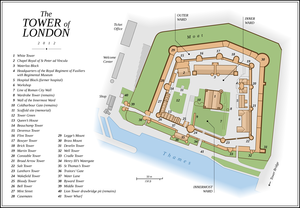
The Tower was built by William the Conqueror as one of two castles either side of London; the other, later known as Baynard's Castle, having long since been demolished). It was an impressinve and intimdating presence, oriented with its strongest and most impressive defences overlooking Saxon London, which archaeologist Alan Vince suggests was deliberate.[2] It would have visually dominated the surrounding area and stood out to traffic on the River Thames.[3]
The castle is made up of three "wards", or enclosures. The innermost ward contains the White Tower and is the earliest phase of the castle built by William. Encircling it to the north, east, and west is the inner ward, built during the reign of Richard I ("the Lionheart) (1189–1199). Finally, there is the outer ward which encompasses the castle and was built under Edward I. Although there were several phases of expansion after William the Conqueror founded the Tower of London, the general layout has remained the same since Edward I completed his rebuild in 1285.
The castle encloses an area of almost 12 acres, with a further 6 acres around the Tower of London constituting the Tower Liberties; land under the direct influence of the castle and cleared for military reasons.[4] The precursor of the Liberties was laid out in the 13th century when Henry III ordered that a strip of land adjacent to the castle be kept clear.[5]
Despite popular fiction, the Tower of London never had a permanent torture chamber, although the basement of the White Tower housed a rack in later periods.[6] Tower Wharf was built on the bank of the Thames under Edward I and was expanded to its current size during the reign of Richard II (1377–1399).[7]
White Tower
The White Tower is the earliest part of the castle, built by William the Conqueror. It is a keep (also known as a donjon); the strongest structure in a mediæval castle, and that which contained lodgings suitable for the lord, in this case the king himself or his constable.[8] The military historian Allen Brown wrote, "The great tower [White Tower] was also, by virtue of its strength, majesty and lordly accommodation, the donjon par excellence".[9] As one of the largest keeps in the Christian world,[10] the White Tower has been described as "the most complete eleventh-century palace in Europe".[11]
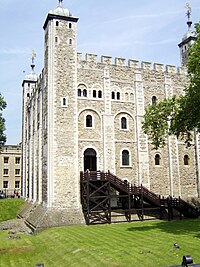
The White Tower, excluding its projecting corner towers, measures 118 feet by 105 feet at the base, and rises to a height of 89 feet at the southern battlements. The structure was originally three storeys high, comprising a basement floor, an entrance level, and an upper floor. The entrance, as is usual in Norman keeps, was above ground, in this case on the south face, and accessed by way of a wooden staircase which could be removed in the event of an attack. It was probably during [Henry II's reign (1154–1189) that a forebuilding was added to the south side of the tower to provide extra defences to the entrance, but it has not survived. Each floor was divided into three chambers, the largest in the west, a smaller room in the north-east, and the chapel taking up the entrance and upper floors of the south-east.[12] At the western corners of the building are square towers, while to the north-east a round tower houses a spiral staircase. At the south-east corner there is a larger semi-circular projection which accommodates the apse of the chapel. As the building was intended to be a comfortable residence as well as a stronghold, latrines were built into the walls, and four fireplaces provided warmth.[11]
The main building material is Kentish rag-stone, although some local mudstone was also used. Caen stone was imported from northern France to provide details in the Tower's facing, although little of the original material survives as it was replaced with Portland stone in the 17th and 18th centuries. As most of the Tower's windows were enlarged in the 18th century, only two original – albeit restored – examples remain, in the south wall at the gallery level.[13]
The tower was terraced into the side of a mound, so the northern side of the basement is partially below ground level.[14] As was typical of most keeps,[15] the bottom floor was an undercroft used for storage. One of the rooms contained a well. Although the layout has remained the same since the tower's construction, the interior of the basement dates mostly from the 18th century when the floor was lowered and the pre-existing timber vaults were replaced with brick counterparts.[14] The basement is lit through small slits.[11]
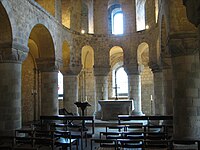
The entrance floor was probably intended for the use of the Constable of the Tower, Lieutenant of the Tower of London and other important officials. The south entrance was blocked during the 17th century, and not reopened until 1973. Those heading to the upper floor had to pass through a smaller chamber to the east, also connected to the entrance floor. The crypt of St John's Chapel occupied the south-east corner and was accessible only from the eastern chamber. There is a recess in the north wall of the crypt; according to Geoffrey Parnell, Keeper of the Tower History at the Royal Armouries, "the windowless form and restricted access, suggest that it was designed as a strong-room for safekeeping of royal treasures and important documents".[14]
The upper floor contained a grand hall in the west and residential chamber in the east - both originally open to the roof and surrounded by a gallery built into the wall - and St John's Chapel in the south-east. The top floor was added in the 15th century, along with the present roof.[12][16] St John's Chapel was not part of the White Tower's original design, as the apsidal projection was built after the basement walls.[14] Due to changes in function and design since the tower's construction, except for the chapel little is left of the original interior.[17] The chapel's current bare and unadorned appearance is reminiscent of how it would have been in the Norman period. In the 13th century, during Henry III's reign, the chapel was decorated with such ornamentation as a gold-painted cross, and stained glass windows that depicted the Holy Trinity and the Virgin Mary.[18]
Innermost ward
The innermost ward encloses an area immediately south of the White Tower, stretching to what was once the edge of the River Thames. As was the case at other castles, such as the 11th-century Hen Domen, the innermost ward was probably filled with timber buildings from the Tower's foundation. Exactly when the royal lodgings began to encroach from the White Tower into the innermost ward is uncertain, although it had happened by the 1170s.[13] The lodgings were renovated and elaborated during the 1220s and 1230s, becoming comparable with other palatial residences such as Windsor Castle.[19] Construction of Wakefield and Lanthorn Towers – located at the corners of the innermost ward's wall along the river – began around 1220.[20] They probably served as private residences for the queen and king respectively. The earliest evidence for how the royal chambers were decorated comes from Henry III's reign: the queen's chamber was whitewashed, and painted with flowers and imitation stonework. A great hall existed in the south of the ward, between the two towers.[21] It was similar to, although slightly smaller than, that also built by Henry III at Winchester Castle.[22] Near Wakefield Tower was a postern gate which allowed private access to the king's apartments. The innermost ward was originally surrounded by a protective ditch, which had been filled in by the 1220s. Around this time, a kitchen was built in the ward.[23] Between 1666 and 1676, the innermost ward was transformed and the palace buildings removed.[24] The area around the White Tower was cleared so that anyone approaching would have to cross open ground. The Jewel House was demolished, and the Crown Jewels moved to Martin Tower.[25]
Inner ward
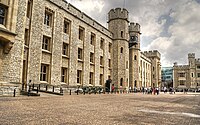
The inner ward was created during Richard the Lionheart's reign, when a moat was dug to the west of the innermost ward, effectively doubling the castle's size.[26][27] Henry III created the ward's east and north walls, and the ward's dimensions remain to this day.[5] Most of Henry's work survives, and only two of the nine towers he constructed have been completely rebuilt.[28] Between the Wakefield and Lanthorn Towers, the innermost ward's wall also serves as a curtain wall for the inner ward.[29] The main entrance to the inner ward would have been through a gatehouse, most likely in the west wall on the site of what is now Beauchamp Tower. The inner ward's western curtain wall was rebuilt by Edward I.[30] The 13th-century Beauchamp Tower marks the first large scale use of brick as a building material in Britain, since the 5th-century departure of the Romans.[31] The Beauchamp Tower is one of 13 towers that stud the curtain wall. Anti-clockwise from the south-west corner they are: Bell, Beauchamp, Devereux, Flint, Bowyer, Brick, Martin, Constable, Broad Arrow, Salt, Lanthorn, Wakefield, and the Bloody Tower.[29] While these towers provided positions from which flanking fire]] could be deployed against a potential enemy, they also contained accommodation. As its name suggests, Bell Tower housed a belfry, its purpose to raise the alarm in the event of an attack. The royal bow-maker, responsible for making longbows, crossbows, catapults, and other siege and hand weapons, had a workshop in the Bowyer Tower. A turret at the top of Lanthorn Tower was used as a beacon by traffic approaching the Tower at night.[32]
As a result of Henry's expansion, St Peter ad Vincula, a Norman chapel which had previously stood outside the Tower, was incorporated into the castle. Henry decorated the chapel by adding glazed windows, and stalls for himself and his queen.[28] It was rebuilt by Edward I at a cost of over £300[33] and again by Henry VIII in 1519; the current building dates from this period, although the chapel was refurbished in the 19th century.[34]
Immediately west of Wakefield Tower, the Bloody Tower was built at the same time as the inner ward's curtain wall, and as a water-gate provided access to the castle from the River Thames. It was a simple structure, protected by a portcullis and gate.[35] The Bloody Tower acquired its name in the 16th century, as it was believed to be the site of the murder of the Princes in the Tower.[36]
Between 1339 and 1341, a gatehouse was built into the curtain wall between Bell and Salt Towers.[37] During the Tudor period, a range of buildings for the storage of munitions was built along the inside of the north inner ward.[38] The castle buildings were remodelled during the Stuart period, mostly under the auspices of the Office of Ordnance. In 1663 just over £4,000 was spent building a new storehouse (now known as the New Armouries) in the inner ward.[39] Construction of the Grand Storehouse north of the White Tower began in 1688, on the same site as the dilapidated Tudor range of storehouses;[40] it was destroyed by fire in 1841. The Waterloo Barracks were built on the site, and remain to this day,[41] housing the Crown Jewels.[42]
Outer ward
A third ward was created during Edward I's extension to the Tower, as the narrow enclosure completely surrounded the castle. At the same time a bastion known as Legge's Mount was built at the castle's north-west corner. Brass Mount, the bastion in the north-east corner, was a later addition. The three rectangular towers along the east wall 15 m apart were dismantled in 1843. Although the bastions have often been ascribed to the Tudor period, there is no evidence to support this; archaeological investigations suggest that Legge's Mount dates from the reign of Edward I.[43] Blocked battlements (also known as crenellations) in the south side of Legge's Mount are the only surviving mediæval battlements at the Tower of London (the rest are Victorian replacements).[44] A new 164-foot moat was dug beyond the castle's new limits;[45] it was originally 15 feet deeper in the middle than it is today.[43] With the addition of a new curtain wall, the old main entrance to the Tower of London was obscured and made redundant; a new entrance was created in the south-west corner of the external wall circuit. The complex consisted of an inner and an outer gatehouse and a barbican,[46] which became known as the Lion Tower as it was associated with the animals as part of the Royal Menagerie since at least the 1330s.[47] The Lion Tower itself no longer survives.[46]
Edward extended the south side of the Tower of London onto land that had previously been submerged by the River Thames. In this wall, he built St Thomas' Tower between 1275 and 1279; later known as Traitors' Gate, it replaced the Bloody Tower as the castle's water-gate. The building is unique in England, and the closest parallel is the now demolished water-gate at the Louvre in Paris. The dock was covered with arrowslits in case of an attack on the castle from the River; there was also a portcullis at the entrance to control who entered. There were luxurious lodgings on the first floor.[48]
Edward also moved the Royal Mint into the Tower; its exact location early on is unknown, although it was probably in either the outer ward or the Lion Tower.[49] By 1560, the Mint was located in a building in the outer ward near Salt Tower.[50] Between 1348 and 1355, a second water-gate, Cradle Tower, was added east of St Thomas' Tower for the king's private use.[37]
Foundation and early history
Victorious at the Battle of Hastings on 14 October 1066, the invading Duke of Normandy, William the Bastard, spent the rest of the year securing his holdings, by fortifying key positions. A series of Norman victories along the route cut London's supply lines and in December 1066, Wliiam entered London.[51][52] Between 1066 and 1087 William established 36 castles, and many more were founded by his subordinates.[53] The new ruling elite undertook what has been described as "the most extensive and concentrated programme of castle-building in the whole history of feudal Europe".[54] They were multi-purpose buildings, serving as fortifications, centres of administration, and residences.[55]
William sent an advance party to prepare the city for his entrance, to celebrate his victory and found a castle; in the words of William's biographer, William of Poitiers, "certain fortifications were completed in the city against the restlessness of the huge and brutal populace. For he [William] realised that it was of the first importance to overawe the Londoners". At the time, London was the largest town in England; the foundation of Westminster Abbey and the old Palace of Westminster under Edward the Confessor had marked it as a centre of governance, and with a prosperous port it was important for the Normans to establish control over the settlement.[52] The other two castles in London – Baynard's Castle and Montfichet's Castle – were established at the same time.[56] The fortification that would later become known as the Tower of London was built onto the south-east corner of the Roman town walls, using them as prefabricated defences, with the River Thames providing additional protection from the south. This earliest phase of the castle would have been enclosed by a ditch and defended by a timber palisade, and probably had accommodation suitable for William.[57]
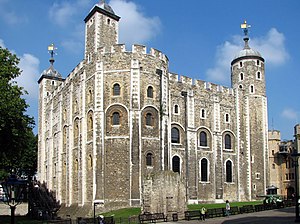
Most of the early Norman castles were built from timber, but by the end of the 11th century a few, including the Tower of London, had been renovated or replaced with stone.[56] Work on the White Tower – which gives the whole castle its name –[10] is usually considered to have begun in 1078, however the exact date is uncertain. William made Gundulf, Bishop of Rochester, responsible for its construction, although it may not have been completed until after William's death in 1087.[10] The White Tower is the earliest stone keep in England, and was the strongest point of the early castle. It also contained grand accommodation for the king.[58] At the latest, it was probably finished by 1100 when Bishop Ranulf Flambard was imprisoned there.[17] Flambard was loathed by the English for exacting harsh taxes. Although he is the first recorded prisoner held in the Tower, he was also the first person to escape from it, using a smuggled rope secreted in a butt of wine. He was held in luxury and permitted servants, but on 2 February 1101 he hosted a banquet for his captors. After plying them with drink, when no one was looking he lowered himself from a secluded chamber, and out of the Tower. The escape came as such a surprise that one contemporary chronicler accused the bishop of witchcraft.[59]
The Anglo-Saxon Chronicle records that in 1097 King William II ordered a wall to be built around the Tower of London; it was probably built from stone and likely replaced the timber palisade that arced around the north and west sides of the castle, between the Roman wall and the Thames.[60]
The death in 1135 of Henry I left England with a disputed succession, for although the king had made his most powerful barons to swear support for his daughter, the Empress Matilda, Stephen of Blois arrived from France within days to lay claim to the throne and swiftly he secured London and the Tower. The castle, which had not been used as a royal residence for some time, was usually left in the charge of a Constable, a post held at this time by the notorious Geoffrey de Mandeville. As the Tower was considered an impregnable fortress in a strategically important position, possession was highly valued, which Mandeville exploited, selling his allegiance to Matilda after Stephen was captured in 1141 at the Battle of Lincoln. Once her support waned, the following year he resold his loyalty to Stephen. Through his role as Constable of the Tower, Mandeville became "the richest and most powerful man in England".[61] When he tried the same ploy again, this time holding secret talks with Matilda, Stephen had him arrested, forced him to cede control of his castles, and replaced him with one of his most loyal supporters, and the post of Constable was not permitted to become hereditary but it remained in the hands of an appointee of the monarch and was usually given to someone of great importance, who might not always be at the castle due to other duties. Although the Constable was still responsible for maintaining the castle and its garrison, from an early stage he had a subordinate to help with this duty: the Lieutenant of the Tower.[61] Constables also had civic duties relating to the city. Usually they were given control of the city and were responsible for levying taxes, enforcing the law and maintaining order. The creation in 1191 of the position of Lord Mayor of London removed many of the Constable's civic powers, and at times led to friction between the two.[62]
Expansion
The castle probably retained its form as established by 1100 until the reign of Richard I (1189–1199).[63] The castle was extended under William Longchamp, Richard's Lord Chancellor and the man in charge of England while he was on crusade. The Pipe Rolls record £2,881 1s 10d spent at the Tower of London between 3 December 1189 and 11 November 1190,[64] from an estimated £7,000 spent by Richard on castle building in England.[65] According to the contemporary chronicler Roger of Howden, Longchamp dug a moat around the castle and tried in vain to fill it from the Thames.[26] Longchamp was also Constable of the Tower, and undertook its expansion while preparing for war with Richard's younger brother, Prince John, who in Richard's absence arrived in England to try to seize power. As Longchamp's main fortress, he made the Tower as strong as possible. The new fortifications were first tested in October 1191, when the Tower was besieged for the first time in its history. Longchamp capitulated to John after just three days, deciding he had more to gain from surrender than prolonging the siege.[66]
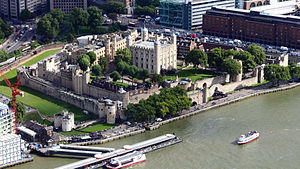
John succeeded Richard as king in 1199, but his rule proved unpopular with many of his barons, who in response moved against him. In 1214, while the king was at Windsor Castle, Robert Fitzwalter led an army into London and laid siege to the Tower. Although under-garrisoned, the Tower resisted and the siege was lifted once John signed the Magna Carta.[67] The king reneged on his promises of reform, leading to the outbreak of the First Barons' War. Even after the Magna Carta was signed, Fitzwalter maintained his control of London. During the war, Fitzwalter and the Tower's garrison joined forces with the barons. In 1216 and the barons offered the English throne to Prince Louis of France, the eldest son of the French king, but after John's death later that year Louis was shunned and John's eldest son became King Henry III, though war and Fitzwalter stayed with the waning faction adhering to Prince Louis until it was clear that Henry's supporters would prevail.[67]
In the 13th century, Kings Henry III (1216–1272) and Edward I (1272–1307) extended the castle, essentially creating it as it stands today.[20] Henry was disconnected from his barons, and a mutual lack of understanding led to unrest and resentment towards his rule. As a result, he was eager to ensure the Tower of London was a formidable fortification, but also to ensure his comfort in residence; from 1216 to 1227 nearly £10,000 was spent on the Tower of London and work at Windsor Castle cost £15,000. Most of the work was focused on the palatial buildings of the innermost ward.[19] The tradition of whitewashing the White Tower (from which it derives its name) began in 1240.[68]
Beginning around 1238, the castle was expanded to the east, north, and north-west. The work lasted through the reign of Henry III and into that of Edward I, interrupted occasionally by civil unrest. New creations included a new defensive perimeter, studded with towers, while on the west, north, and east sides, where the wall was not defended by the river, a defensive ditch was dug. The eastern extension took the castle beyond the bounds of the old Roman settlement, marked by the city wall which had been incorporated into the castle's defences.[68] The Tower had long been a symbol of oppression, despised by Londoners, and Henry's building programme was unpopular. So when the gatehouse collapsed in 1240, the locals celebrated the setback.[69] The expansion caused disruption locally and £166 was paid to St Katherine's Hospital and the prior of Holy Trinity in compensation.[70]
Henry III often held court at the Tower of London, and held a parliament there on at least two occasions (1236 and 1261) when he felt that the barons were becoming dangerously unruly. When in 1258, Simon de Montfort and the barons forced the King to agree to reforms, relinquishing the Tower of London was among the conditions. Henry resented losing power and sought permission from the pope to break his oath then with the backing of mercenaries the King installed himself in the Tower in 1261 until a truce was agreed, by which he handed control of the Tower over once again. Henry returned after his victory at the Battle of Evesham in 1265, allowing him to regain control of the country and the Tower of London. The pope's envoy came to England to excommunicate those who were still rebellious and was granted custody of the Tower, causing another rebellion; Gilbert de Clare, 6th Earl of Hertford, marched on London in April 1267 and laid siege to the castle, declaring that custody of the Tower was "not a post to be trusted in the hands of a foreigner, much less of an ecclesiastic".[71] Despite a large army and siege engines, Earl Gilbert was unable to take the castle and he retreated. The Tower experienced peace for the rest of Henry's reign.[72]
Although he was rarely in London, Edward I undertook an expensive remodelling of the Tower, costing £21,000 between 1275 and 1285, over double that spent on the castle during the whole of Henry III's reign.[73] Edward I was a seasoned castle builder, and used his experience of siege warfare during the crusades to bring innovations to castle building.[73] His programme of castle building in Wales heralded the introduction of the widespread use of arrowslits in castle walls across Europe, drawing on Eastern influences.[74] At the Tower of London, Edward filled in the moat dug by Henry III and built a new curtain wall along its line, creating a new enclosure. A new moat was created in front of the new curtain wall. The western part of Henry III's curtain wall was rebuilt, with Beauchamp Tower replacing the castle's old gatehouse. A new entrance was created, with elaborate defences including two gatehouses and a barbican.[75] In an effort to make the castle self-sufficient, Edward I also added two watermills.[76] Six hundred Jews were imprisoned in the Tower of London in 1278, charged with coin clipping;[77] the persecution of the Jews culminated in 1290 when King Edward issued the Edict of Expulsion.
Later mediæval period
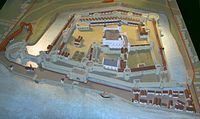
During Edward II's reign (1307–1327) there was relatively little activity at the Tower of London.[78] However, it was during this period that the Privy Wardrobe was founded. The institution was based at the Tower and responsible for organising the state's arms.[79] Margaret de Clare, Baroness Badlesmere became the first woman imprisoned in the Tower of London after she refused Queen Isabella admittance to Leeds Castle[80] and ordered her archers to fire upon Isabella, killing six of the royal escort.[81][82][83] Generally reserved for high-ranking inmates, the Tower was the most important royal prison in the country.[84] However it was not necessarily very secure, and throughout its history prisoners bribed guards to help them escape. In 1322 in the reign of Edward II, Roger Mortimer, 1st Earl of March, was aided in his escape from the Tower by the Sub-Lieutenant of the Tower who let Mortimer's men inside: they hacked a hole in his cell wall and Mortimer escaped to a waiting boat for France. Having seduced Edward's Queen, Mortimer returned, captured the Tower, released the prisoners held there and imprisoned the King in Pomfret, later having him murdered. For three years Mortimer ruled the realm while Edward III was too young, but in 1330, Edward threw Mortimer back into the Tower.[85]
King Edward III (1312–1377) restored English power and prosperity and later in his realm he restored the dilapidated Tower of London.
When Richard II was crowned in 1377, he led a procession from the Tower to Westminster Abbey, which began a tradition which lasted until the coronation of King Charles II. During the Peasants' Revolt of 1381 the Tower of London was besieged with the King inside. When Richard rode out to meet with Wat Tyler, the rebel leader, a crowd broke into the castle without meeting resistance and looted the Jewel House. The Archbishop of Canterbury, Simon Sudbury, took refuge in St John's Chapel, hoping the mob would respect the sanctuary but he was taken away and beheaded on Tower Hill.[86] Six years later there was again civil unrest, and Richard spent Christmas in the security of the Tower rather than Windsor as was more usual.[87] When Henry Bolingbroke returned from exile in 1399, King Richard was imprisoned in the White Tower, where he was forced to abdicate in favour of Henry, though it did him little good: Richard was murdered in the Tower.
In the 15th century the Tower was a place of refuge and imprisonment; when supporters of the late Richard II attempted a coup, Henry IV found safety in the Tower of London. During this period, the castle also held many distinguished prisoners. The heir to the Scottish throne, later King James I, was kidnapped while journeying to France in 1406 and held in the Tower; he was still here when proclaimed king. The vistories in France of [[Henry V (1413–1422) brought many high-status prisoners to be held in the Tower of London until they were ransomed.[88]
The mid-15th century was rent by the Wars of the Roses. In 1460 the Tower was besieged and damaged by Yorkist artillery, and surrendered when Henry VI was captured at the Battle of Northampton. After a brief restoration, Henry was imprisoned in the Tower, where he was probably murdered.[86] During the wars, the Tower was fortified to withstand gunfire, and provided with loopholes for cannons and handguns: an enclosure was created for this purpose to the south of Tower Hill, although it no longer survives.

Shortly after the death of Edward IV in 1483, Richard Duke of Gloucester imprisoned his nephews in the Tower of London; the twelve year old King Edward VI and his younger brother Richard. The "Princes in the Tower", as they are known to history, were probably murdered here which act is one of the most infamous events associated with the Tower of London. The Duke of Gloucester was proclaimed King Richard III in July 1483; the princes were last seen in public in June 1483. Bones thought to belong to them were discovered in 1674 when the 12th-century forebuilding at the entrance to the White Tower was demolished; however, the reputed level at which the bones were found (ten feet) would put the bones at a depth similar to that of the recently discovered Roman graveyard found twelve feet underneath the Minories a few hundred yards to the north.[89]
Changing use
The fall of Richard III and the beginning of the Tudor period marked the start of the decline of the Tower of London's use as a royal residence. As 16th-century chronicler Raphael Holinshed said the Tower became used more as "an armouries and house of munition, and thereunto a place for the safekeeping of offenders than a palace roiall for a king or queen to sojourne in".[90] The Yeoman Warders have been the Royal Bodyguard since at least 1509.[91] During the reign of Henry VIII, the Tower was assessed as needing considerable work on its defences. In 1532 Thomas Cromwell spent £3,593 on repairs and imported nearly 3000 tons of Caen stone for the work.[34] Even so, this was not sufficient to bring the castle up to the standard of contemporary military fortifications which were designed to withstand powerful artillery.[92] Although the defences were repaired, the palace buildings were left in a state of neglect after Henry's death. Their condition was so poor that they were virtually uninhabitable.[90] From 1547 onwards, the Tower of London was only used as a royal residence when its political and historic symbolism was considered useful, for instance each of Edward VI, Mary I and Elizabeth I briefly stayed at the Tower before their coronations. In Elizabeth's case it was a happier return than her former visit when she was cast into prison in the Tower by her own sister.[93]
In the 16th century, the Tower acquired an enduring reputation as a grim, forbidding prison. This had not always been the case. As a royal castle, it was used by the monarch to imprison people for various reasons, however these were usually high-status individuals for short periods rather than common citizenry as there were plenty of prisons elsewhere for such people. Contrary to the popular image of the Tower, prisoners were able to make their life easier by purchasing amenities such as better food or tapestries through the Lieutenant of the Tower.[94] As holding prisoners was originally an incidental role of the Tower – as would have been the case for any castle – there was no purpose-built accommodation for prisoners until 1687 when a brick shed, a "Prison for Soldiers", was built to the north-west of the White Tower. The Tower's reputation for torture and imprisonment derives largely from 16th-century religious propagandists and 19th-century romanticists.[95] Although much of the Tower's reputation is exaggerated, the 16th and 17th centuries marked the castle's zenith as a prison, with many religious and political undesirables locked away.[95] The Privy Council had to sanction the use of torture, so it was not often used; between 1540 and 1640, the peak of imprisonment at the Tower, there were 48 recorded cases of the use of torture. The three most common forms used were the infamous rack, the Scavenger's daughter, and manacles.[96] The rack was introduced to England in 1447 by the Duke of Exeter, the Constable of the Tower; consequentially it was also known as the Duke of Exeter's daughter.[97]
Among those held and executed at the Tower was Anne Boleyn.[95] Although the Yeoman Warders were once the Royal Bodyguard, by the 16th and 17th centuries their main duty had become to look after the prisoners.[98] The Tower was often a safer place than other prisons in London such as the Fleet, where disease was rife. High-status prisoners could live in conditions comparable to those they might expect outside; one such example was that while Walter Raleigh was held in the Tower his rooms were altered to accommodate his family, including his son who was born there in 1605.[96] Executions were usually carried out on Tower Hill rather than in the Tower of London itself, and 112 people were executed on the hill over 400 years.[99] Before the 20th century, there had been seven executions within the castle on Tower Green; as was the case with Lady Jane Grey, this was reserved for prisoners for whom public execution was considered dangerous.[99] After Lady Jane Grey's execution on 12 February 1554,[100] Queen Mary I imprisoned her sister Elizabeth, later Queen Elizabeth I, in the Tower under suspicion of causing rebellion as Sir Thomas Wyatt had led a revolt against Mary in Elizabeth's name.[101]
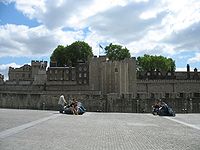
The Office of Ordnance and Armoury Office were founded in the 15th century, taking over the Privy Wardrobe's duties of looking after the monarch's arsenal and valuables.[102] As there was no standing army before 1661, the importance of the royal armoury at the Tower of London was that it provided a professional basis for procuring supplies and equipment in times of war. The two bodies were resident at the Tower from at least 1454, and by 16th century they had moved to a position in the inner ward.[103] Political tensions between Charles I and Parliament in the second quarter of the 17th century led to an attempt by forces loyal to the King to secure the Tower and its valuable contents, including money and munitions. London's Trained Bands, a militia force, were moved into the castle in 1640. Plans for defence were drawn up and gun platforms were built, readying the Tower for war. The preparations were never put to the test. In 1642, Charles I attempted to arrest five members of parliament. When this failed he fled the city, and Parliament retaliated by removing Sir John Byron, the Lieutenant of the Tower. The Trained Bands had switched sides, and now supported Parliament; together with the London citizenry, they blockaded the Tower. With permission from the King, Byron relinquished control of the Tower. Parliament replaced Byron with a man of their own choosing, Sir John Conyers. By the time the Civil War broke out in November 1642, the Tower of London was already in Parliament's control.[104]
The last monarch to uphold the tradition of taking a procession from the Tower to Westminster to be crowned was Charles II in 1660. At the time, the castle's accommodation was in such poor condition that he did not stay there the night before his coronation.[105] Under the Stuart kings the Tower's buildings were remodelled, mostly under the auspices of the Office of Ordnance. Just over £4,000 was spent in 1663 on building a new storehouse, now known as the New Armouries in the inner ward.[39] In the 17th century there were plans to enhance the Tower's defences in the style of the trace italienne, however they were never acted on. Although the facilities for the garrison were improved with the addition of the first purpose-built quarters for soldiers (the "Irish Barracks") in 1670, the general accommodations were still in poor condition.[106]
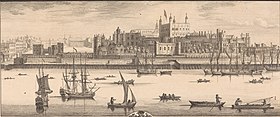
When the Hanoverian dynasty ascended the throne, their situation was uncertain and with a possible rebellion in mind, the Tower of London was repaired. Gun platforms added under the Stuarts had decayed. The number of guns at the Tower was reduced from 118 to 45, and one contemporary commentator noted that the castle "would not hold out four and twenty hours against an army prepared for a siege".[107] For the most part, the 18th-century work on the defences was spasmodic and piecemeal, although a new gateway in the southern curtain wall permitting access from the wharf to the outer ward was added in 1774.
The moat surrounding the castle had become silted over the centuries since it was created despite attempts at clearing it. It was still an integral part of the castle's defences, so in 1830 the Constable of the Tower, the Duke of Wellington, ordered a large-scale clearance of several feet of silt. However this did not prevent an outbreak of disease in the garrison in 1841 caused by poor water supply, resulting in several deaths. To prevent the festering ditch posing further health problems, it was ordered that the moat should be drained and filled with earth. The work began in 1843 and was mostly complete two years later. The construction of the Waterloo Barracks in the inner ward began in 1845, when the Duke of Wellington laid the foundation stone. The building could accommodate 1,000 men; at the same time, separate quarters for the officers were built to the north-east of the White Tower. The building is now the headquarters of the Royal Regiment of Fusiliers.[108] The popularity of the Chartist movement between 1828 and 1858 led to a desire to refortify the Tower of London in the event of civil unrest. It was the last major programme of fortification at the castle. Most of the surviving installations for the use of artillery and firearms date from this period.[109]
During the First World War, eleven men were tried in private and shot by firing squad at the Tower for espionage.[110] During the Second World War, the Tower was once again used to hold prisoners of war. One such person was Rudolf Hess, Adolf Hitler's deputy, albeit just for four days in 1941. He was the last state prisoner to be held at the castle.[111] The last person to be executed at the Tower was German spy Josef Jakobs who was shot on 15 August 1941.[112] The executions for espionage during the wars took place in a prefabricated miniature rifle range which stood in the outer ward and was demolished in 1969.[113] The Second World War also saw the last use of the Tower as a fortification. In the event of a German invasion, the Tower, together with the Royal Mint and nearby warehouses, was to have formed one of three "keeps" or complexes of defended buildings which formed the last-ditch defences of the capital.[114]
Restoration and tourism
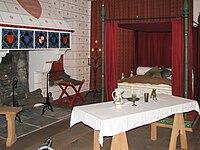
The Tower of London has become established as one of the most popular tourist attractions in the country. It has been a tourist attraction since at least the Elizabethan period, when it was one of the sights of London that foreign visitors wrote about. Its most popular attractions were the Royal Menagerie and displays of armour. The Crown Jewels also garner much interest, and have been on public display since 1669. The Tower steadily gained popularity with tourists through the 19th century, despite the opposition of the Duke of Wellington to visitors. Numbers became so high that by 1851 a purpose-built ticket office was erected. By the end of the century, over 500,000 were visiting the castle every year.[115]
Over the 18th and 19th centuries, the palatial buildings were slowly adapted for other uses and demolished. Only the Wakefield and St Thomas' Towers survive.[105] The 18th century marked an increasing interest in England's mediæval past. One of the effects was the emergence of Gothic Revival architecture. In the Tower's architecture, this was manifest when the New Horse Armoury was built in 1825 against the south face of the White Tower. It featured elements of Gothic Revival architecture such as battlements. Other buildings were remodelled to match the style and the Waterloo Barracks were described as "castellated Gothic of the 15th century".[116][117] Between 1845 and 1885 institutions such as the Mint which had inhabited the castle for centuries moved to other sites; many of the post-mediæval structures left vacant were demolished. In 1855 the War Office took over responsibility for manufacture and storage of weapons from the Ordnance Office, which was gradually phased out of the castle. At the same time, there was greater interest in the history of the Tower of London.[116]
Public interest was partly fuelled by contemporary writers, of whom the work of William Harrison Ainsworth was particularly influential. In The Tower of London: A Historical Romance he created a vivid image of underground torture chambers and devices for extracting confessions that stuck in the public imagination.[95] Harrison also played another role in the Tower's history, as he suggested that Beauchamp Tower should be opened to the public so they could see the inscriptions of 16th- and 17th-century prisoners. Working on the suggestion, Anthony Salvin refurbished the tower and led a further programme for a comprehensive restoration at the behest of Prince Albert. Salvin was succeeded in the work by John Taylor. When a feature did not meet his expectations of mediæval architecture Taylor would ruthlessly remove it; as a result, several important buildings within the castle were pulled down and in some cases post-mediæval internal decoration removed.[118]
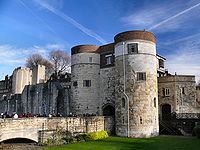
Only one bomb fell on the Tower of London in the First World War (it landed harmlessly in the moat), but the Second World War left a greater mark. On 23 September 1940, during the Blitz, high-explosive bombs damaged the castle, destroying several buildings and narrowly missing the White Tower. After the war, the damage was repaired and the Tower of London was reopened to the public.[119]
In 1974, there was a bomb explosion in the Mortar Room in the White Tower, leaving one person dead and 35 injured. No one claimed responsibility for the blast, but the police investigated suspicions that the IRA was behind it.[120]
In the 21st century tourism is the Tower's primary role, the remaining routine military activities, under the Royal Logistic Corps, having wound down in the latter half of the century and moved out of the castle.[119] However, the Tower is still home to the ceremonial regimental headquarters of the Royal Regiment of Fusiliers, and the museum dedicated to it and its predecessor, the Royal Fusiliers.[121][122] Also, a detachment of the unit providing the Queen's Guard at Buckingham Palace still mounts a guard at the Tower, and with the Yeomen Warders, takes part in the Ceremony of the Keys each day.[123][124][125] On several occasions through the year gun salutes are fired from the Tower by the Honourable Artillery Company, these consist of 62 rounds for royal occasions, and 41 on other occasions.[126]
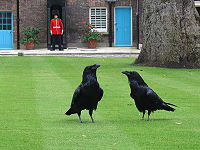
The Tower of London is cared for by an independent charity, Historic Royal Palaces, which receives no funding from the Government or the Crown.[127] In 1988, the Tower of London was added to the UNESCO list of World Heritage Sites, in recognition of its global importance and to help conserve and protect the site.[128][129] However, recent developments, such as the construction of skyscrapers nearby, have pushed the Tower towards being added to the United Nations' Heritage in Danger List.[130] The remains of the mediæval palace have been open to the public since 2006. Visitors can explore the chambers restored to their former glory, once used by past kings and queens.[131] Although the position of Constable of the Tower remains the highest position held at the Tower,[132] the responsibility of day-to-day administration is delegated to the Resident Governor.[133] At least six ravens are kept at the Tower at all times, in accordance with the belief that if they are absent, the kingdom will fall.[134] They are under the care of the Yeomen Warders. The earliest known reference to a Tower raven is a picture from 1883.[135] As well as having ceremonial duties, the Yeoman Warders provide guided tours around the Tower.[91][98] According to Historic Royal Palaces, over 2.4 million people visited the Tower of London in the year to March 2011.
Crown Jewels
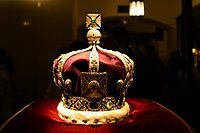
The tradition of housing the Crown Jewels in the Tower of London probably dates from the reign of Henry III. The Jewel House was built specifically to house the royal regalia, including jewels, plate, and symbols of royalty such as the crown, sceptre, and sword. When money needed to be raised, the treasure could be pawned by the monarch. A new position for "keeper of the jewels, armouries and other things" was created,[136] which was well rewarded; in the reign of Edward III (1312–1377) the holder was paid 12d a day. The position grew to include other duties including purchasing royal jewels, gold, and silver, and appointing royal goldsmiths and jewellers.[136]
In 1649, during the Civil War, the contents of the Jewel House were disposed of along with other royal properties. Metal items were sent to the Mint to be melted down and re-used, and the crowns were "totallie broken and defaced".[137] When the monarchy was restored in 1660, the only surviving items of the coronation regalia were a 12th-century spoon and three ceremonial swords. The rest of the Crown Jewels had to be recreated. In 1669, the Jewel House was demolished[25] and the Crown Jewels moved into Martin Tower where they could be viewed by the paying public. This was exploited two years later when Colonel Thomas Blood attempted to steal them.[115] Blood and his accomplices bound and gagged the Jewel House keeper. Although they laid their hands on the Imperial State Crown, Sceptre and Orb, they were foiled when the keeper's son turned up unexpectedly and raised the alarm.[137][138] The Crown Jewels are currently stored in the Waterloo Barracks at the Tower.[42]
Menagerie
The Royal Menagerie is first heard of during the reign of Henry III. In 1251, the sheriffs were ordered to pay fourpence a day towards the upkeep for the King's polar bear; the bear attracted a great deal of attention from Londoners when it went fishing in the Thames. In 1254, the sheriffs were ordered to subsidise the construction of an elephant house at the Tower.[77] The exact location of the mediæval menagerie is unknown, although the lions were kept in the barbican known as Lion Tower.[139] The royal collection was swelled by diplomatic gifts including three leopards from Frederick III, the Holy Roman Emperor. By the 18th century, the menagerie was open to the public; admission cost three half-pence or the supply of a cat or dog to be fed to the lions.[140] In 1828 there were over 280 animals representing at least 60 species[141] The last of the animals left in 1835, relocated to Regents Park, after one of the lions was accused of biting a soldier.[142] The Keeper of the Royal Menagerie was entitled to use the Lion Tower as a house for life. Consequently, even though the animals had long since left the building, the Lion Tower was not demolished until the last keeper's death in 1853.[142]
Outside links
| ("Wikimedia Commons" has material about Tower of London) |
- The Tower of London
- Further reading recommended by Historic Royal Palaces
- Bibliography of sources relating to the Tower of London
References
- ↑ tower of London website – Last Prisoners
- ↑ Vince 1990 in Creighton 2002, p. 138
- ↑ Creighton 2002, p. 138
- ↑ Parnell 1993, p. 11
- ↑ 5.0 5.1 Parnell 1993, pp. 32–33
- ↑ Wilson 1998, p. 39
- ↑ Parnell 1993, p. 49
- ↑ Friar 2003, p. 163
- ↑ Allen Brown 1976, p. 15
- ↑ 10.0 10.1 10.2 Allen Brown 1976, p. 44
- ↑ 11.0 11.1 11.2 Impey & Parnell 2000, p. 16
- ↑ 12.0 12.1 Parnell 1993, pp. 20–23
- ↑ 13.0 13.1 Parnell 1993, p. 22
- ↑ 14.0 14.1 14.2 14.3 Parnell 1993, p. 20
- ↑ Friar 2003, p. 164
- ↑ Impey & Parnell 2000, p. 17
- ↑ 17.0 17.1 Allen Brown & Curnow 1984, p. 12
- ↑ Parnell 1993, p. 32
- ↑ 19.0 19.1 Parnell 1993, p. 27
- ↑ 20.0 20.1 Allen Brown & Curnow 1984, p. 17
- ↑ Parnell 1993, p. 28
- ↑ Impey & Parnell 2000, p. 31
- ↑ Allen Brown & Curnow 1984, pp. 17–18
- ↑ Parnell 1993, p. 65
- ↑ 25.0 25.1 Parnell 1993, p. 67
- ↑ 26.0 26.1 Allen Brown & Curnow 1984, pp. 15–17
- ↑ Parnell 1993, p. 24
- ↑ 28.0 28.1 Parnell 1993, p. 33
- ↑ 29.0 29.1 Parnell 1993, p. 10
- ↑ Parnell 1993, pp. 34–35
- ↑ Parnell 1993, p. 42
- ↑ Wilson 1998, p. 34
- ↑ Parnell 1993, p. 46
- ↑ 34.0 34.1 Parnell 1993, p. 55
- ↑ Parnell 1993, p. 29
- ↑ Bloody Tower, Historic Royal Palaces, http://www.hrp.org.uk/TowerOfLondon/Sightsandstories/Prisoners/Towers/BloodyTower.aspx, retrieved 22 July 2010
- ↑ 37.0 37.1 Parnell 1993, p. 47
- ↑ Parnell 1993, p. 58
- ↑ 39.0 39.1 Parnell 1993, p. 64
- ↑ Parnell 1993, p. 70
- ↑ Parnell 1993, p. 90
- ↑ 42.0 42.1 Jewel House, Historic Royal Palaces, http://www.hrp.org.uk/Hireavenue/venuesandsuppliers/TowerofLondon/venues/thejewelhouse.aspx, retrieved 22 June 2010
- ↑ 43.0 43.1 Parnell 1993, pp. 35–37
- ↑ Parnell 1993, pp. 43–44
- ↑ Impey & Parnell 2000, p. 34
- ↑ 46.0 46.1 Parnell 1993, pp. 40–41
- ↑ Impey & Parnell 2000, p. 36
- ↑ Parnell 1993, pp. 38–39
- ↑ Parnell 1993, p. 43
- ↑ Parnell 1993, p. 61
- ↑ Bennett 2001, pp. 45–47
- ↑ 52.0 52.1 Wilson 1998, p. 1
- ↑ Allen Brown 1976, p. 30
- ↑ Allen Brown 1976, p. 31
- ↑ Friar 2003, p. 47
- ↑ 56.0 56.1 Wilson 1998, p. 2
- ↑ Allen Brown & Curnow 1984, pp. 5–9
- ↑ Allen Brown & Curnow 1984, pp. 9–10
- ↑ Wilson 1998, pp. 5–6
- ↑ Allen Brown & Curnow 1984, pp. 12–13
- ↑ 61.0 61.1 Wilson 1998, pp. 6–9
- ↑ Wilson 1998, pp. 14–15
- ↑ Allen Brown & Curnow 1984, p. 13
- ↑ Allen Brown & Curnow 1984, p. 15
- ↑ Gillingham 2002, p. 304
- ↑ Wilson 1998, pp. 13–14
- ↑ 67.0 67.1 Wilson 1998, pp. 17–18
- ↑ 68.0 68.1 Allen Brown & Curnow 1984, p. 20
- ↑ Wilson 1998, p. 21
- ↑ Allen Brown & Curnow 1984, pp. 20–21
- ↑ Wilson 1998, pp. 24–27
- ↑ Wilson 1998, p. 27
- ↑ 73.0 73.1 Parnell 1993, p. 35
- ↑ Cathcart King 1988, p. 84
- ↑ Parnell 1993, pp. 35–44
- ↑ Wilson 1998, pp. 31
- ↑ 77.0 77.1 Parnell 1993, p. 54
- ↑ Impey & Parnell 2000, p. 41
- ↑ Lapper & Parnell 2000, p. 28
- ↑ Wilson 1998, p. 40
- ↑ Costain 1958, pp. 193–195
- ↑ Calendar of Patent Rolls. 1321–1327. p. 29
- ↑ Strickland 1840, p. 201
- ↑ Friar 2003, p. 235
- ↑ Wilson 1998, pp. 34, 42–43
- ↑ 86.0 86.1 Parnell 1993, p. 53
- ↑ Impey & Parnell 2000, p. 44
- ↑ Impey & Parnell 2000, p. 45
- ↑ Kennedy, Maev (29 October 2013). "Roman eagle found by archaeologists in City of London". The Guardian. http://www.theguardian.com/science/2013/oct/29/roman-eagle-found-archaeologists-london-sculpture-art. Retrieved 5 November 2013.
- ↑ 90.0 90.1 Impey & Parnell 2000, p. 51
- ↑ 91.0 91.1 Yeoman Warders, Historic Royal Palaces, http://www.hrp.org.uk/TowerOfLondon/stories/yeomanwarder.aspx, retrieved 21 July 2010
- ↑ Impey & Parnell 2000, p. 73
- ↑ Impey & Parnell 2000, p. 52
- ↑ Wilson 1998, pp. 10–11
- ↑ 95.0 95.1 95.2 95.3 Impey & Parnell 2000, p. 91
- ↑ 96.0 96.1 Impey & Parnell 2000, p. 92
- ↑ Black 1927, p. 345
- ↑ 98.0 98.1 Parnell 1993, p. 117
- ↑ 99.0 99.1 Impey & Parnell 2000, p. 94
- ↑ Plowden 2004
- ↑ Collinson 2004
- ↑ Impey & Parnell 2000, p. 47
- ↑ Impey & Parnell 2000, p. 57
- ↑ Impey & Parnell 2000, p. 74
- ↑ 105.0 105.1 Impey & Parnell 2000, pp. 54–55
- ↑ Parnell 1993, pp. 76–77
- ↑ Impey & Parnell 2000, p. 78
- ↑ Impey & Parnell 2000, pp. 79–80
- ↑ Impey & Parnell 2000, p. 81
- ↑ (PDF) Executions at The Tower of London, Historic Royal Palaces, http://www.hrp.org.uk/Resources/Executions%20at%20the%20Tower.pdf, retrieved 31 July 2010
- ↑ Impey & Parnell 2000, p. 123
- ↑ Sellers 1997, p. 179
- ↑ Parnell 1993, pp. 117–118
- ↑ Osbourne, Mike (2012), Defending London: A Military History from Conquest to Cold War, The History Press Ltd, ISBN 978-0-7524-6465-7 (p. 167)
- ↑ 115.0 115.1 Parnell 1993, p. 111
- ↑ 116.0 116.1 Impey & Parnell 2000, p. 117
- ↑ Parnell 1993, p. 96
- ↑ Impey & Parnell 2000, pp. 118–121
- ↑ 119.0 119.1 Impey & Parnell 2000, p. 124
- ↑ On This Day 1974: Bomb blast at the Tower of London, BBC News Online, 17 July 1974, http://news.bbc.co.uk/onthisday/hi/dates/stories/july/17/newsid_2514000/2514429.stm, retrieved 16 June 2010
- ↑ "Regimental History", British Army (Royal Regiment of Fusiliers), 2010, http://www.army.mod.uk/infantry/regiments/5452.aspx, retrieved 16 June 2010
- ↑ Royal Regiment of Fusiliers (London) Museum, Army Museums Ogilby Trust, archived from the original on 26 July 2011, http://web.archive.org/web/20110726064711/http://www.armymuseums.org.uk/museums/0000000114-Royal-Regiment-of-Fusiliers-London-Museum.htm, retrieved 16 June 2010
- ↑ The Ceremony of the Keys, Historic Royal Palaces, 2004–2010, http://www.hrp.org.uk/TowerOfLondon/WhatsOn/ceremonyofthekeys.aspx, retrieved 16 June 2010
- ↑ The Queen's Guard, British Army, 2010, http://www.army.mod.uk/events/ceremonial/1071.aspx, retrieved 16 June 2010
- ↑ Yeomen Warders, Royal Household of the United Kingdom, 2008/09, http://www.royal.gov.uk/RoyalEventsandCeremonies/Ceremonialbodies/YeomenWarders.aspx, retrieved 16 June 2010
- ↑ Gun salutes, Royal Household of the United Kingdom, 2008/09, http://www.royal.gov.uk/RoyalEventsandCeremonies/GunSalutes/Gunsalutes.aspx, retrieved 16 June 2010
- ↑ Cause and principles, Historic Royal Palaces, http://www.hrp.org.uk/aboutus/whoweare/causeandprinciples.aspx, retrieved 201-04-30
- ↑ UNESCO Constitution, UNESCO, http://portal.unesco.org/en/ev.php-URL_ID=15244&URL_DO=DO_TOPIC&URL_SECTION=201.html, retrieved 17 August 2009
- ↑ Tower of London, UNESCO, http://whc.unesco.org/en/list/488, retrieved 28 July 2009
- ↑ UNESCO warning on Tower of London, BBC News Online, 21 October 2006, http://news.bbc.co.uk/1/hi/england/london/6072580.stm, retrieved 16 June 2010
- ↑ Mediæval Palace: Press Release, Historic Royal Palaces, http://www.hrp.org.uk/NewsAndMedia/Pressresources/tolpressresources/pressreleasemediævalTower.aspx, retrieved 19 July 2010
- ↑ The Constable of the Tower, Historic Royal Palaces, http://www.hrp.org.uk/TowerOfLondon/stories/palacepeople/TheConstableoftheTower.aspx, retrieved 27 September 2010
- ↑ Maj Gen Keith Cima: Resident Governor HM Tower of London, Historic Royal Palaces, archived from the original on 6 December 2008, http://web.archive.org/web/20081206190019/http://www.hrp.org.uk/aboutus/whoweare/MajorGeneralKeithCima_.aspx, retrieved 27 September 2010
- ↑ Jerome 2006, pp. 148–149
- ↑ Sax 2007, pp. 272–274
- ↑ 136.0 136.1 Wilson 1998, p. 29
- ↑ 137.0 137.1 Impey & Parnell 2000, p. 106
- ↑ Colonel Blood's raid, Historic Royal Palaces, http://www.hrp.org.uk/TowerOfLondon/stories/anattempttostealthecrownjewels.aspx, retrieved 22 June 2010
- ↑ Parnell 1993, pp. 40, 54
- ↑ Blunt 1976, p. 17
- ↑ African History at the Tower of London. Tower Hamlets: Tower Hamlets African and Caribbean Mental Health Organisation. 2008. p. 16. ISBN 978-0-9551368-7-0.
- ↑ 142.0 142.1 Parnell 1993, p. 94
- Allen Brown, Reginald (1976) [1954], Allen Brown's English Castles, The Boydell Press, ISBN 1-84383-069-8
- Allen Brown, Reginald; Curnow, P (1984), Tower of London, Greater London: Department of the Environment Official Handbook, Her Majesty's Stationary Office, ISBN 0-11-671148-5
- Bennett, Matthew (2001), Campaigns of the Norman Conquest, Essential Histories, Osprey Publishing, ISBN 1-84176-228-8
- Black, Ernest (1927), "Torture under English Law", University of Pennsylvania Law Review and American Law Register (University of Pennsylvania) 75 (4): 344–348, doi:10.2307/3307506
- Blunt, Wilfred (1976), The Ark in the Park: The Zoo in the Nineteenth Century, Hamish Hamilton, ISBN 0-241-89331-3
- Cathcart King, David James (1988), The Castle in England and Wales: an Interpretative History, Croom Helm, ISBN 0-918400-08-2
- Collinson, Patrick (2004), "Elizabeth I (1533–1603), Queen of England and Ireland", Oxford Dictionary of National Biography, Oxford University Press, http://www.oxforddnb.com/view/article/8636
- Costain, Thomas (1958), The Three Edwards, Garden City
- Creighton, Oliver (2002), Castles and Landscapes, Continuum, ISBN 0-8264-5896-3
- Farson, Daniel (1978), Ghosts in Fact and Fiction, Hamlyn Young Books, ISBN 978-0-600-34053-9
- Friar, Stephen (2003), The Sutton Companion to Castles, Sutton Publishing, ISBN 978-0-7509-3994-2
- John Gillingham (2002) [1999], Richard I, Yale University Press, ISBN 0-300-09404-3
- Hole, Christina (1951), Haunted England: A Survey of English Ghost-Lore (3 ed.), Batsford
- Horrox, Rosemary (2004), "Edward V (1470–1483), king of England and lord of Ireland", Oxford Dictionary of National Biography, Oxford University Press, http://www.oxforddnb.com/view/article/8521
- Impey, Edward; Parnell, Geoffrey (2000), The Tower of London: The Official Illustrated History, Merrell Publishers in association with Historic Royal Palaces, ISBN 1-85894-106-7
- Jerome, Fiona (2006), Tales from the Tower: Secrets and Stories from a Gory and Glorious Past, Think Publishing, ISBN 978-1-84525-026-3
- Lapper, Ivan; Parnell, Geoffrey (2000), The Tower of London: A 2000-year History, Osprey Publishing, ISBN 978-1-84176-170-1
- Liddiard, Robert (2005), Castles in Context: Power, Symbolism and Landscape, 1066 to 1500, Windgather Press Ltd, ISBN 0-9545575-2-2
- Parnell, Geoffrey (1993), The Tower of London, Batsford, ISBN 978-0-7134-6864-9
- Plowden, Alison (2004), "Grey (married name Dudley), Lady Jane (1537–1554)", Oxford Dictionary of National Biography, Oxford University Press, http://www.oxforddnb.com/view/article/8154
- Roud, Steve (2009) [2008], London Lore: The Legends and Traditions of the World's Most Vibrant City, Arrow Books, ISBN 978-0-09-951986-7
- Sax, Boria (2007), "How Ravens Came to the Tower of London" (PDF), Society and Animals 15 (3): 269–283, doi:10.1163/156853007X217203, http://www.animalsandsociety.org/assets/library/737_s4.pdf
- Sellers, Leonard (1997), Shot in the Tower:The Story of the Spies executed in the Tower of London during the First World War, Leo Cooper, ISBN 978-1-84884-026-3
- Strickland, Agnes (1840), Lives of the Queens of England from the Norman Conquest. Volume II, II, Henry Colburn
- Vince, Alan (1990), Saxon London: An Archaeological Investigation, Seaby, ISBN 1-85264-019-7
- Wilson, Derek (1998) [1978], The Tower of London: A Thousand Years (2nd ed.), Allison & Busby, ISBN 0-7490-0332-4
Further reading
- Bennett, Edward Turner (1829), The Tower Menagerie: Comprising the Natural History of the Animals Contained in that Establishment; with Anecdotes of their Characters and History, Robert Jennings
- Harman, A. (1864), Sketches of the Tower of London as a Fortress, a Prison, and a Palace, J. Wheeler
- Parnell, Geoffrey (2009), The Tower of London: Past & Present, History Press, ISBN 978-0-7524-5036-0
| World Heritage Sites in the United Kingdom |
|---|
|
Bath • Blaenavon Industrial Landscape • Blenheim Palace • Canterbury Cathedral, St Augustine's Abbey & St. Martin's Church • Castles and Town Walls of King Edward I • Cornwall and West Devon Mining Landscape • Derwent Valley Mills • Durham Castle & Cathedral • Edinburgh Old Town & New Town • Forth Bridge • Frontiers of the Roman Empire: Antonine Wall & Hadrian's Wall • Giant's Causeway • Ironbridge Gorge • Jurassic Coast • Kew Gardens • Liverpool Maritime Mercantile City • Maritime Greenwich • New Lanark • Heart of Neolithic Orkney • Pontcysyllte Aqueduct • St Kilda • Saltaire • Stonehenge, Avebury & Associated Sites • Studley Royal Park & Fountains Abbey • Tower of London • Palace of Westminster, Westminster Abbey & St Margaret's Church |


